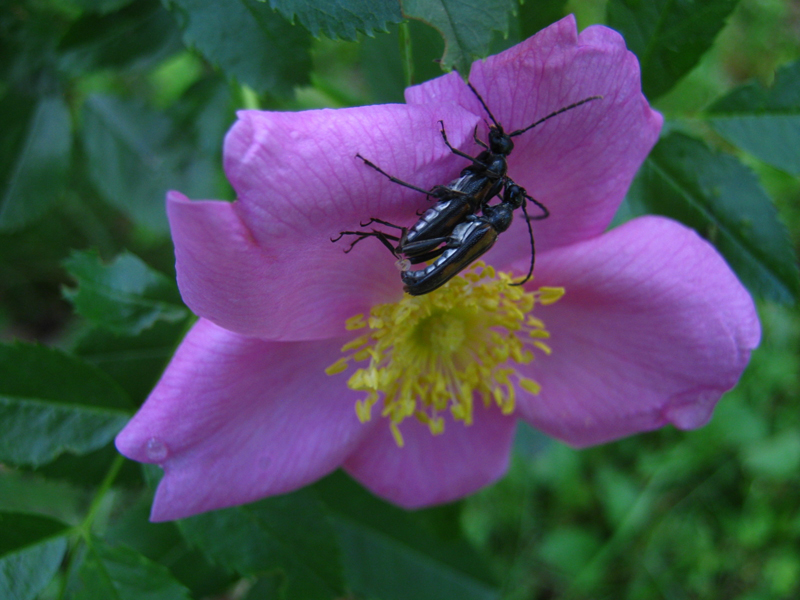Normally you don’t think of insects in connection with Eros. I mean, we humans by and large associate love with beauty. And what could be uglier than bugs?
But besides their unspeakably violent hunting, gathering and devouring, a major part of bug adult lives is spent reproducing. A lot of them copulate, which could really bring some non-erotic imagery to mind, and even that can go pretty badly for the males of some species. Some female mantids eat the mate after the act, or even during. You have to want it pretty bad to dive into that.
Yet for us, like them I guess, love comes in at the eye, or some perceptor. “Only God, my dear, can love you for yourself alone, and not your yellow hair,” or some such poetic nonsense. And once the physical expressions of love settle down, reality sets in, and by that I mean: offspring.
Kids live whole different lives, some of whose pains and joys you might remember firsthand — or be reminded of by your own offspring. Most of the human turbulence involves transformations from toddlerhood into kidhood, from kidhood to adolescence, and finally adulthood. Hopefully. It’s not their growing bodies, so much, that are the trouble. It’s their inner, emotional lives metamorphosing from one stage to the next so completely that some of them turn unrecognizable: child, teen, adult.
Anyway, I got curious about bug love and its consequences recently when I caught two beetles apparently in the act on (appropriately enough) a wild rose blossom, thorns and all. To make a long investigative story short, they turned out to be blister beetles, and they were indeed engaged in the love function — or whatever it is to them.
Adult blister beetles, like a lot of creatures, engage in pre-copulatory foreplay. I missed the erotic preliminaries for these two, but they will for up to an hour move about and rub each other with their antennae or palps (fingerlike appendages near the mouth) while perched atop food plants. When ready, they copulate for up to four hours rear-mount style, like a lot of other six-, four- and two-legged beasts. The female then lays 50 to several hundred eggs in dirt crevices, under stones or sometimes on the plants, including notably clover and alfalfa. This normally happens in mid- to late summer.
The eggs hatch in around two weeks, and then things start to get bizarre. Most insects metamorphose through three or four stages of life (egg, larva, adult; or egg, larva, pupa, adult), and each stage can be unrecognizable as the same species as the previous one, let alone the same individual. These blister beetles, though, don’t just metamorphose — they hypermetamorphose.
This means they go through not one or two phases, or instars, after hatching, but six or seven, depending on their species and location. The first larval instar is a small item practically all tail with legs and an antlike face (at least, so it appears in the entomologists’ drawings). It attaches itself to a bee and travels off to find food, which in our area is mainly grasshopper eggs. After gorging itself, it starts developing through three or four more larval stages (collectively known by entomologists as “first grub”), in each of which its legs get smaller and its body gets bigger and blockier. When it reaches the last of the first grub instars, it’s pretty much legless. These phases take about four weeks.
This grub, practically immobile, digs a hole. It metamorphoses into its second grub phase and then pupates into a kind of curled up creep (not a technical term) with folded appendages. If food sources are unfavorable for the pupa, it can retro-molt back to the first grub instar, wait out the winter and re-emerge to pupate again the next summer. (I know some parents have wished this could happen with teenagers. But this is an anomaly of bug physiology, not of human psychology.) Finally, it becomes an adult and sets about eating plants, including potatoes, and reproducing repeatedly during its one to four-month adult life (according to species and conditions).
They’re called blister beetles because when tampered with, the adults exude from their leg joints a chemical called cantharidin that can raise a pretty nasty-looking blister on your skin. In fact cantharidin is so toxic that a big enough belt of it incidentally ingested from beetles patrolling alfalfa or clover can kill horses.
It also has another kind of bizarre application. Cantharidin is the active ingredient in an aphrodisiac sometimes called Spanish fly, named after the European species of blister beetle it’s extracted from.
Now, Spanish fly apparently does work for men. Cantharidin is quite a strong irritant, and so as it travels through the urinary tract, it can increase blood flow to the nether organs and induce, well, priapism. By all accounts, it is not particularly pleasant, and can, in extreme conditions, kill you.
You have to want it pretty bad to dive into that. I don’t think golden-haired Aphrodite or her offspring, or their instars, are associated with it. Speaking as a human, I mean, with a capacity to at least catch glimpses of supernatural beauty.
Dana Wilde lives in Troy. His writings on the Maine woods are collected in “The Other End of the Driveway,” available from Booklocker.com. Backyard Naturalist appears the second and fourth Thursdays each month. You can contact him at naturalist@dwildepress.net.
Send questions/comments to the editors.




Success. Please wait for the page to reload. If the page does not reload within 5 seconds, please refresh the page.
Enter your email and password to access comments.
Hi, to comment on stories you must . This profile is in addition to your subscription and website login.
Already have a commenting profile? .
Invalid username/password.
Please check your email to confirm and complete your registration.
Only subscribers are eligible to post comments. Please subscribe or login first for digital access. Here’s why.
Use the form below to reset your password. When you've submitted your account email, we will send an email with a reset code.